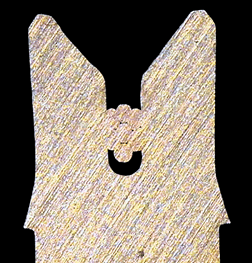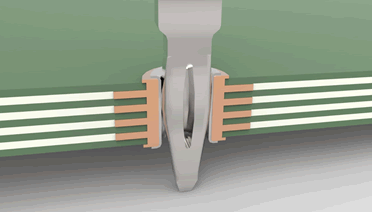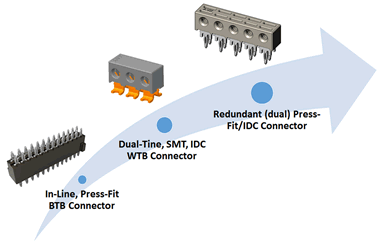A Perfect Marriage: The Future of IDC and Press-Fit Contacts in Automotive
Automotive applications can benefit from a combination of IDC and press-fit contacts thanks to their contact geometries and high-performance base materials
By Tom Anderson, Connector Product Manager, AVX
For more than a decade, insulation displacement contact (IDC) and press-fit or compliant pin technology have proven to be two of the most reliable contact systems in critical automotive applications. Deployed in a variety of systems, such as airbag, engine, and transmission control units (i.e., vehicular computers), these high-reliability contacts provide continuous gas-tight or cold-welded terminations throughout the life of the vehicle.
To achieve this ultra-reliable level of interconnect, each contact goes through different levels of both elastic and plastic deformations during the wire or PCB insertion process. Once in the final seated position, both contact systems continuously maintain an applied force (expansion or compression) to ensure contact integrity even during exposure to extreme temperature, shock, vibration, and thermal expansion.

Figure 1
The IDC cross section in Figure 1 shows a typical stranded wire connection with the wire inserted between opposing phosphor bronze contact tines, which exhibit superior fatigue resistance over extreme temperature and deflection ranges. During the insertion process, the individual strands are physically altered in shape as they are compressed into the “U” slot of the contact, which has been dimensionally matched to a specific wire diameter. Thanks to material thickness and contact geometry, the IDC tines have enough elasticity to smooth out the forces generated during the wire insertion process. This prevents the tines from cutting into the individual conductors and ultimately weakening the connection. The opposing tines then maintain a high level of compression force onto the wire to maintain a continuous gas-tight connection throughout extreme environmental conditions.
A very common practice in the automotive industry is to encapsulate electronic modules or wire terminations with potting compounds to weatherproof them and protect them from moisture ingress. Traditional elastic-only (i.e., compression-spring-force-only) contact systems cannot guarantee that the potting material will not migrate into the contact joint during the potting process or thermal expansion. Oftentimes, if there are failures in spring-force-only connections, they will be longer-term and not visible during the assembly process. Alternately, properly designed IDC terminations eliminate the ability for the potting material to migrate in between the contact and the conductor.

Figure 2
The press-fit or compliant pin section in Figure 2 depicts a pin already inserted into a plated-through-hole (PTH) in a PCB. While the pin is inserted into the hole, it goes through the very same elastic and plastic deformation process as in the IDC. Again, the unique eye-of-the-needle geometry of the pin and the inherent properties of the base phosphor bronze material provide sufficient flexibility to deform and compress during the insertion process, effectively preventing any damage or scarring of the plated through-hole, which can jeopardize the long-term reliability of the connection. The result is a high-opposing-force or active contact system that adjusts as needed to maintain a high-integrity connection in even the harshest conditions.
One of the key drivers for the automotive market’s switch over to press-fit terminations is the resulting long-term, active or continuous contact force applied within the plated through-hole. As vehicle electronic systems become more sophisticated and the age of our vehicles began to extend, traditional soldered connector systems began to exhibit failures due to age or solder embrittlement.
Both IDC and press-fit or compliant pin contact technologies offer years of experience behind their design, development, and integration into connection systems. IDC was first developed in the early 1960s, and the compliant pin emerged in the late 1970s. Both started out as computer-level connection systems and then went through several different iterations of geometry and material selections as they morphed into the high-reliability, industry-proven automotive wire and PCB-level connection solutions they are widely recognized as today. Now long-proven in the market in standalone connection systems, both of these contact systems also owe much of their high-reliability reputation to the superior performance characteristics of their base phosphor bronze material, the grade or composition of which (e.g., CuSN6, CuNiSi, and STOL78) can be adjusted based on end-customer application requirements, including: temperature extremes, enhanced conductivity, and demanding tensile or yield strength requirements.
A new generation of connectors that combines these two contact technologies into a perfect marriage of materials and contact geometries is currently being developed to create a double-ended, gas-tight, wire-to-board (WTB) connection system especially designed for harsh environment automotive applications.

Figure 3
Figure 3 illustrates the transformation from individual solutions into a combined package that will offer automotive designers effective new solutions for discrete WTB connections. One of the biggest advantages of this innovation is the elimination of costly two-piece connector systems in harsh or demanding applications that rely solely on elastic-only, spring-force contact systems. This new, combined connector has also been designed with dual-assembly methodologies in mind. It can be pre-installed onto the PCB during the board build process, allowing wires to be inserted and pressed into place with any standard flat rock seating tool upon final assembly, and also offers the option of a pre-installed connector on the wire harness, allowing it to be pressed into the PCB upon final assembly. This second process lends itself especially well to conformal coating processes in which the board and components need to be protected from the environment. In such a case, the PTH pattern can be simply covered with Kapton® or another similar tape during the coating process, as it removes easily, allowing the connector harness to be pressed into place.
In addition to a standard WTB interface, this new contact technology will offer new packaging options for connecting two PCBs that are in close proximity, but not in the same orientation or alignment location for a traditional board-to-board connector. Again, rather than using multiple two-piece connectors, which add cost, they allow a simple jumper assembly to be easily and reliably pressed into place. These types of connections are often made with an FFC/FPC type of cable, which jumpers between two zero insertion force (ZIF) connectors. However, while functional, assuring proper manual insertion of the full depth of cable into these types of connectors requires special care and inspection, especially in high-vibration applications in which the actuator could potentially open up. Another significant advantage that the new combined contact will provide over FFC/FPC type connectors is the ability to use multiple color-coded discrete wire gauges (18 – 24AWG) to address higher current-carrying capabilities, which can facilitate easier and more traditional wire dressing and routing throughout a vehicle.
Based on the combination of high-performance base material and proven contact technologies, this new generation of connectors — which is currently being released to market for engineering evaluation in harsh automotive applications — stands poised to help the quality-conscious automotive market overcome design challenges to enable the next generation of high-reliability vehicular electronics.
[hr]
Tom Anderson has been in the connector industry for more than 30 years, and has held a variety of product marketing positions. For the last 10 years, he has been focused on developing new connector technologies for the automotive, industrial, and solid-state lighting markets. [email protected] | www.avx.com
Recently posted:
[related_posts limit=”10″]






